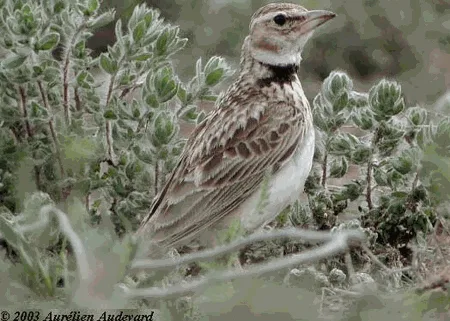
Bimaculated Lark
[order] PASSERIFORMES | [family] Alaudidae | [latin] Melanocorypha bimaculata | [UK] Bimaculated Lark | [FR] Alouette monticole | [DE] Berg-Kalanderlerche | [ES] | [NL] Bergkalanderleeuwerik
Subspecies
| Genus | Species | subspecies | Breeding Range | Breeding Range 2 | Non Breeding Range |
| Melanocorypha | bimaculata | EU | sc | n India, ne AF | |
| Melanocorypha | bimaculata | bimaculata | |||
| Melanocorypha | bimaculata | rufescens | |||
| Melanocorypha | bimaculata | torquata |
Physical charateristics
About 10% smaller and relatively longer-winged than Calandra Lark. Medium-sized to large lark, of closely similar appearance to Calandra Lark but differing in whiter supercilium (in adult), darker lores, narrower but usually longer black crescents on upper breast, and absence of obvious white trailing edge to wings and sides to tail, which instead shows white terminal spots. In autumn, cheeks rusty. Underwing less dark than Calandra Lark. Wing and tail pattern allow ready separation from Calandra Lark in close flight view but care always needed in observations of bird on ground or flying at distance. General character differs most in more pointed bill, shorter tail, and lesser bulk; proportionately longer wings noticeable on take-off.
| wingspan min.: | 33 | cm | wingspan max.: | 41 | cm |
| size min.: | 16 | cm | size max.: | 17 | cm |
| incubation min.: | 12 | days | incubation max.: | 13 | days |
| fledging min.: | 9 | days | fledging max.: | 13 | days |
| broods: | 2 | eggs min.: | 2 | ||
| eggs max.: | 5 |
Range
Eurasia : Southcentral
Habitat
In lower-middle warm continental latitudes, in higher and rougher parts of steppe zone, replacing Calandra Lark up to at least 1650 m in Afghanistan, 2000 m in Armenia. Ascends mountains to limit of crops, and occurs on cultivated plateaux at high altitudes; also on dry heath, shrubland, stony tracts, and almost bare steppes. During migration uses lake shores, and fields of rice and stubble. Winters in India in barren semi-desert, sparse cultivation, harvested and fallow fields, margins of jheels, and on dry tidal mudflats.
Reproduction
Breeding season in Armenia: laying begins first few days of May; latest fresh clutches mid-July. Possibly 2 broods. Nest is built on ground in shelter of tussock or low bush, usually shaded from sun at hottest time of day. Nest: shallow scrape, lined with grasses and rootlets, walls of coarser material than floor; also clad in bits of old dung, rag, paper, etc. The eggs are sub-elliptical to oval, smooth and glossy; white, greyish, or brownish, occasionally with olive tinge, heavily or lightly spotted and speckled, sometimes in patches, with light or dark brown and some pale purple. Clutch: 3-5, rarely 6 and are incubate for 12-13 days. Young leave the nest at about 9 days, before they are able to fly.
Feeding habits
Insects and seeds. When taking cultivated Sorghum, feeds either by nipping out grain from low seed heads (especially when seed still soft), by perching on large seed heads (more often as seed ripens), or by collecting fallen grain. In Sudan, recorded doing considerable damage by digging up freshly sown grain.
Conservation
This species has an extremely large range, and hence does not approach the thresholds for Vulnerable under the range size criterion (Extent of Occurrence <20,000 km2 combined with a declining or fluctuating range size, habitat extent/quality, or population size and a small number of locations or severe fragmentation). The population trend appears to be stable, and hence the species does not approach the thresholds for Vulnerable under the population trend criterion (>30% decline over ten years or three generations). The population size is extremely large, and hence does not approach the thresholds for Vulnerable under the population size criterion (<10,000 mature individuals with a continuing decline estimated to be >10% in ten years or three generations, or with a specified population structure). For these reasons the species is evaluated as Least Concern.
Melanocorypha bimaculata is a widespread summer visitor to Turkey and parts of
the Caucasus, with Europe accounting for less than a quarter of its global breeding
range. Its European breeding population is very large (>1,000,000 pairs), but its
trend between 1970-1990 was unknown. The species was stable in Armenia and
Azerbaijan during 1990-2000, but the stronghold population in Turkey increased,
and the species probably underwent a small increase overall. Consequently, it is
evaluated as Secure.
Melanocorypha bimaculata is a widespread summer visitor to Turkey and parts of
the Caucasus, with Europe accounting for less than a quarter of its global breeding
range. Its European breeding population is very large (>1,000,000 pairs), but its
trend between 1970-1990 was unknown. The species was stable in Armenia and
Azerbaijan during 1990-2000, but the stronghold population in Turkey increased,
and the species probably underwent a small increase overall. Consequently, it is
evaluated as Secure.

Migration
Migratory. Some winter on southern edge of breeding range, but majority migrate south to Pakistan and north-west India, Middle East, and north-east Africa. Timing of passages poorly known but, as in Calandra Lark, main periods appear to be October-November and March-April.
Distribution map

